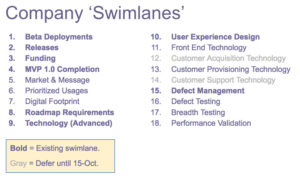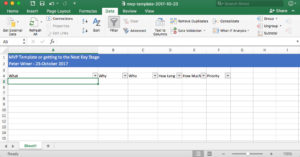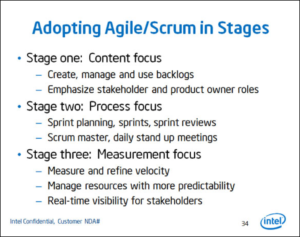Minimum Viable Product (MVP) is a key ingredient of Agile. MVP is a product with just enough features to satisfy early customers, and to provide feedback for future product development. Teams can easily sprint with an MVP Spreadsheet using familiar tools and processes.
This is a continuation of my series, “Agile Agile: The Agile adoption of Agile methodologies”. The previous article “Adopting Agile as a Second Language”, focused on evangelizing Agile and getting started with minimum disruption.
Reaching MVP can be the most important milestone for Agile teams in both startups and established organizations. An MVP can be tested with real users. This can justify further product development or reveal required course corrections. In the worst case, testing disproves key assumptions and allows a team to stop development, cutting their losses.
Venture investing and standup comedy

I like comparing this to stand-up comedy. As a comedian, you can practice endlessly in front of a mirror. Until you try your jokes in front of an audience – giving your MVP to real users – you don’t know if the jokes are actually funny. Anybody can make their family laugh. Funny people can make their friends laugh. Only a true comedian can make total strangers laugh.
And the same applies to products. Many entrepreneurs can convince friends and family to make small investments in their companies. Gifted storytellers with exciting ideas can raise seed money from wealthy casual investors. Multiple forms of proof and justification are required to raise large rounds of Series A funding from professional venture capitalists. A robust validated MVP is just one of these proofs.
MVP or Next Key Stage
In my consulting practice, I work with entrepreneurs in early-stage startups. My focus is helping startups evolve from Seed to Series A. We typically develop multiple ‘swimlanes’ that define milestones for products, funding, intellectual property, branding, recruiting and other key factors. In this context, the journey to MVP is a swimlane but it also impacts other swimlanes more broadly.

MVP is the earliest product version that satisfies some users. Reaching MVP is a vital milestone that helps enable funding. This is true in startups where the funding comes from outside investors and established companies where funding comes through a budget process. The MVP can be used to support patents and trademarks, build partnerships and attract talent. MVP can enable progress in multiple swimlanes.
Sometimes it makes sense to broaden MVP thinking beyond product features. The process of defining MVP can be extended and viewed as the Next Key Stage. What are the minimum requirements for moving our team to the Next Key Stage of development, maturity, funding or liquidity. In this sense, MVP is concrete value that’s created when a team finishes the next set of key work.
Break down MVP into a set of ‘things’
From the narrow perspective, MVP is a list of features. More broadly it’s a list of features, tasks, assets, artifacts and proofs. It’s what you need to reach the next stage. It’s a list. For each ‘thing’ on the list you need to answer the following questions:
- What is it?
- Why do we need it?
- Who is going to do it?
- How long will it take?
- How much will it cost?
My preferred ‘flavor’ of Agile is relatively formal. I like purpose-built tools like Rally and Target Process. I believe there are big benefits to writing user stories, organizing sprints, driving burndown, measuring velocity, building stakeholder dashboards and following priorities. That said, I also recognize the benefit of lighter weight tools like Jira, GitLab, Zenkit and Trello.
But I’ve also come to learn that adopting new tools is rarely easy. Many startups implement Agile in spreadsheets. It’s important to recognize the benefits of spreadsheet-based Agile and harvest strategic value without requiring any process change or new tools. I believe there’s a good way to describe MVP in a spreadsheet and use it to guide effective Agile development.
Starting an MVP Spreadsheet

Start with an empty spreadsheet to make a list of all MVP work. Gather your team around a big screen or a shared screen on Skype or WebEx. Everyone provides ideas and one person types them into a single column named, “What”. The ideas will come thick and fast until everyone has their say.
When the flow tapers off start the second column named “Why”. Don’t overthink the reasons or worry about consistency. Just provide one or two words for each thing. You can go back and adjust later. Categories will emerge and the relationships to swimlanes will become apparent.
In a recent exercise, most things fell into four categories:
- Prerequisite – we can’t do anything else until this is done
- Feature – users will be unhappy without it
- Proves science – our unique approach and competitive advantage
- Digital footprint – seeds our online brand
It’s easy to see how these can support various swimlanes leading to the Next Key Stage.
Next, work on the “Who” column. For each thing provide one or two names. You can also use terms like “anybody”, “new hire”, “TBD”, “chief data scientist” or the name of an outside partner.
Make estimates in the “How Long” and “How Much” columns. I also recommend making the spreadsheet sortable. This allows easy grouping by “Why” and “Who”.
Sort, rank and think

Now start sorting, ranking and thinking. This could expose imbalances in the “Who” column. One or more team members will be overloaded with work. Nobody else is qualified to do it. This is a good time to add another column named “Priority”. Contents of the column could be “yes” and “no”, “high” and “low”, whatever works for you. Adjust “Who” and “Priority” until nobody is overloaded with top priority things.
If you can’t resolve overloading for a team member, you might need to move some of their things to “new hire” and make a “Prerequisite” thing for hiring a new team member.
While sorting and ranking, you can start making “How Long” estimates. Consider subdividing any thing that’s bigger than 2 weeks. This process works better when all things are 2 weeks or smaller. You can also start estimating “How Much”. Sometimes things with high costs must be postponed until resources are acquired or otherwise become available. Acquiring resources can be specified in additional “Prerequisite” things.
Sort, rank and sprint

Sort by “Priority”. This reveals the most important set of things, balanced across team members and feasible in 2 weeks. This is sprint 1. My article titled, “Adopting Agile as a Second Language” explains how to use this to start a series of sprints leading to completion of MVP or – more broadly – the Next Key Stage for your team or startup company.
This is the ultimate use of “Agile Agile”. You can move to Agile without learning new tools and without learning challenging new processes.
